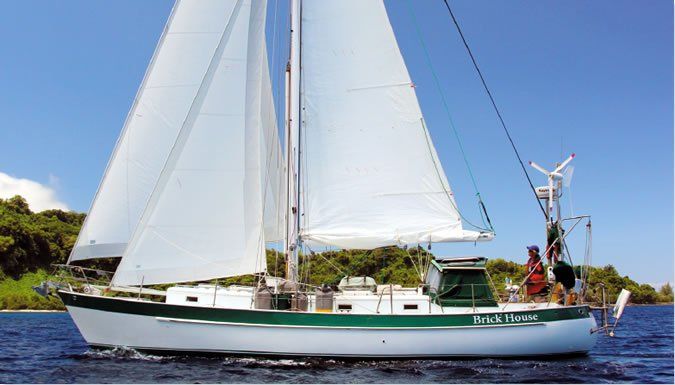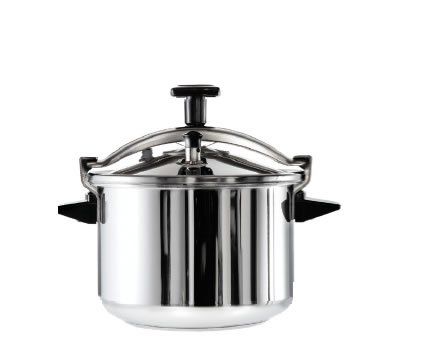Frontal Strategy
In response to the June 15, 2016 blog post titled Summer Squall Sailing Tactics: From our experience, most localized fronts are marked by a gray sky transitioning to a definite line of approaching black clouds, which will bring 20- to 35-knot winds. Once in a while, we see more severe frontal transitions from clear blue sky to a roiling black line of clouds, blasting in far higher wind speeds. I cannot imagine any reason to leave any part of a mainsail up to face an initial slam of localized weather.
Photos courtesy of Patrick Childress and Tefal

With a storm/staysail set, and if we feel the need to get through the weather as quickly as possible, we turn to head bow into the weather, so we can just hold our own and let the weather blow on by. Otherwise, if the situation is tolerable, we just continue on our way with the little staysail.
The last thing to have up in a passing localized front is the mainsail. Having to turn into the wind and dump a main while it is trying to flog itself to death is a quick way to add to a boats list of needed repairs. To run off the wind or downwind under main is not a good choice. As sailing author Bill Seifert says, It is easier to pull a sailboat than to push it. This means that the main, with its center of effort located aft and to the side,, will torque a boat around, making for demanding steering and increasing the risk of gybing. A jib, with its pulling effort far forward, is a much steadier trim going down or off the wind.
We very rarely see tornadoes at sea, but recently, while passing through a well-defined localized front, our boat was surrounded by five small, powerful, whirling dervishes that were hoovering up the ocean along the fronts leading edge. They moved off past our stern as our bow headed deeper into the torrential rain in the core of the storm. We did turn on the engine, in case we had to make some drastic maneuver to avoid a tornado, but they did not wander about.
Patrick Childress
PS contributor and bluewater cruiser
Brick House, Valiant 40
Thailand

Pressure Cooker Report
When our trusty Athenium pressure cooker became obsolete due to difficulty in obtaining spares, we followed Practical Sailors recommendation and purchased a Duromatic cooker (see PS December 2010 online). After five years of voyaging with it, we can say that it did not live up to your top billing when used exclusively on a boat.
We used the pressure cooker frequently, and after a time, we had increasing problems getting the lid to pressurize, despite changing the rubber seals regularly, and we found the plastic fittings on the lid top to be prone to breakage. Eventually, we bought an SEB cooker, which has given yeoman service over the last 12 months.
Ted Pearson
Denique, Gailey Ocean Raiders design
Lyttelton, New Zealand
Keel Integrity
After over 35 years of inspecting manufacturing defects and service damage in sailboats, I heartily agree with Practical Sailors cautious evaluation of the adequacy of keel-attachment specifications from the various regulatory agencies (see PS May 2016 online). I regret that I cannot discuss the more interesting cases I have worked on due to disclosure restrictions. Regardless, I can offer a few observations that may be of interest, most related to manufacturing techniques, not necessarily scan’tlings.
First, the specification that the composites in way of keel fastener penetrations equal or exceed the fastener diameter seems a bit disingenuous to me as laminate schedules typically double-up in way of the canoe body centerline, or down in the sump, so the thickness spec is not hard to meet even though the nearby skin thickness may well be only half as thick. Note that abruptly ending the overlapped schedule can also cause problems.
The centerline plies, I think, should be gradually stepped off, the typical drop-off interval being not less than an inch, to avoid creating a hard spot-stress concentration. Note that this can be very hard to accomplish deep down in a sump sidewall. Best practice, in my opinion, is to incrementally interleave the port and starboard side plies, rather than all of one sides plies on top of the other side, particularly when secondary bonds are involved.
There are many boats where the keel floors do not run all the way down to the bottom of the sump, but rather stopped a few inches above it. Tabbing failures along the frames, down the sidewalls of the sump, were all too common on these boats. The explanation I got from the builder was that running the floors all the way to the sump bottom caused a tabbing-tailoring nightmare, and thus produced a non-flat surface for the keel fasteners to land on. This is why high-compression-strength bedding putties exist.
Whats wrong, I often wondered, with keel fasteners that are a bit longer than necessary? I have lost count of the ones I have seen with only a thread or two showing above the nuts, which often do not have proper washers underneath them. I can also recall at least three boats where practical repairs were abandoned because the keel fasteners were too short to work with.
It is a mistake to look only immediately in way of where the keel fasteners penetrate the hull when evaluating this part of a boats construction. Look closely at the outboard toes of the keel floors. If the ends are not carefully tabbed, right to the very ends, the locations invite delamination that will run down the tabbing. Watch out for line bubbles at the inside corner roots of the tabbing-a problem easily solved with a radiused swipe of the proper formulation putty.
Check where the keel floors end. One group of boats comes to mind where the keel floors ended well inboard of the tabbing for the vertical face of the seats, creating a weak zone in between two stiff regions of the hull shell. Most of these hulls were recalled for retrofitting with wider keel floors.
Unidirectional caps across the tops of keel floors are great. It takes very skillful tailoring of woven or knit fabrics to maintain fiber continuity without missing laminate windows across the 90-degree intersections of longitudinal and transverse keel floors, which is no doubt why I have seen so many tabbing failures at these intersections. Again, a putty radius makes avoiding vertical line bubbles much easier.
Where and how the hull coring stops near the keel and the solid laminate construction begins also play a big role in keel-attachment failures. Butt-core edges with line bubbles are bad news; gradually tapered edges are much smarter. Water, as we know, runs downhill, and deterioration of forest-product cores at the edge of the core termination adjacent to the keel (affected by water leaking in from above, for example, from leaking rubrail fasteners), can cause a local rotten-core weak spot prone to failure.
Limber holes? I have lost count of the number of times I have seen keel floor delamination start at crudely executed limber holes or systems pass-throughs. Drilling big holes in highly loaded structures is asking for trouble.
A final thought: Although infusion does produce high-fiber content laminates, the squeeze of the vacuum bag often buckles laminates, especially in way of multiple dry plies in highly curved regions like a garboard turn or the wrap down into a sump. Buckled plies are much weaker than smooth ones, and Ive seen at least three examples of hull shell and keel attachment failures, or hull rejections during construction due to this problem.


































